E-Technology: Risks, Benefits and Supplier Strategies in Business
VerifiedAdded on 2023/06/10
|10
|2907
|330
Essay
AI Summary
This essay examines the profound impact of e-technologies on contemporary society and business operations. It begins by highlighting the expansion of e-commerce and its influence across various sectors, emphasizing how e-technologies have reshaped social lifestyles by offering flexibility, convenience, and enhanced communication. The essay delves into the benefits of e-technology, such as improved information dissemination, reduced market barriers, and secure transaction platforms. However, it also addresses the associated risks, including privacy concerns, security breaches, and the potential for data leakage. The role of suppliers in mitigating these risks is a key focus, with discussion on strategies like training, security measures, and the use of advanced technologies to ensure data integrity and user authentication. The conclusion emphasizes the importance of e-technology in modern business and human life, highlighting how organizations can leverage it for market expansion and customer engagement, while also mitigating risks to gain a competitive edge.
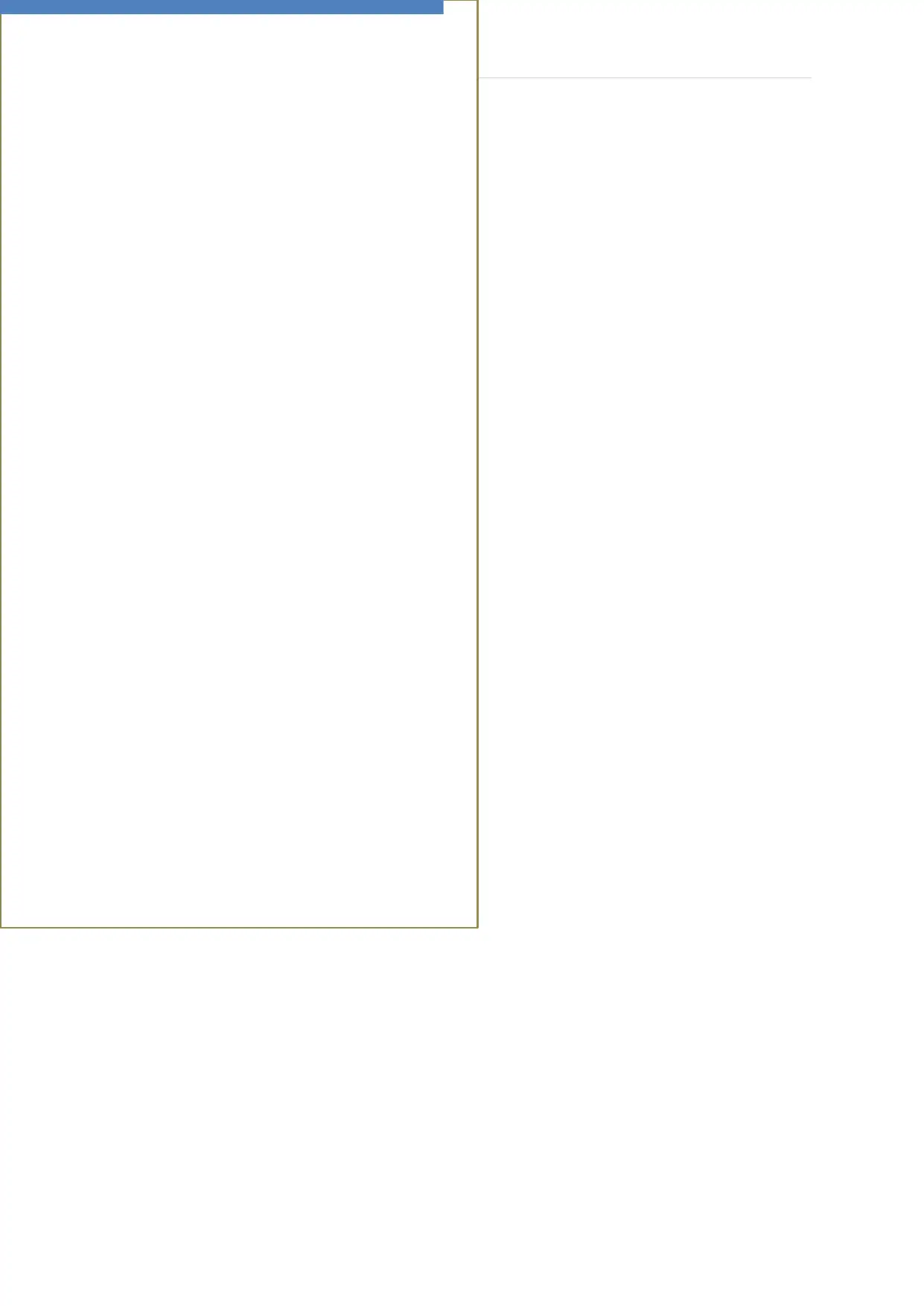
0 | P a g e
Paraphrase This Document
Need a fresh take? Get an instant paraphrase of this document with our AI Paraphraser
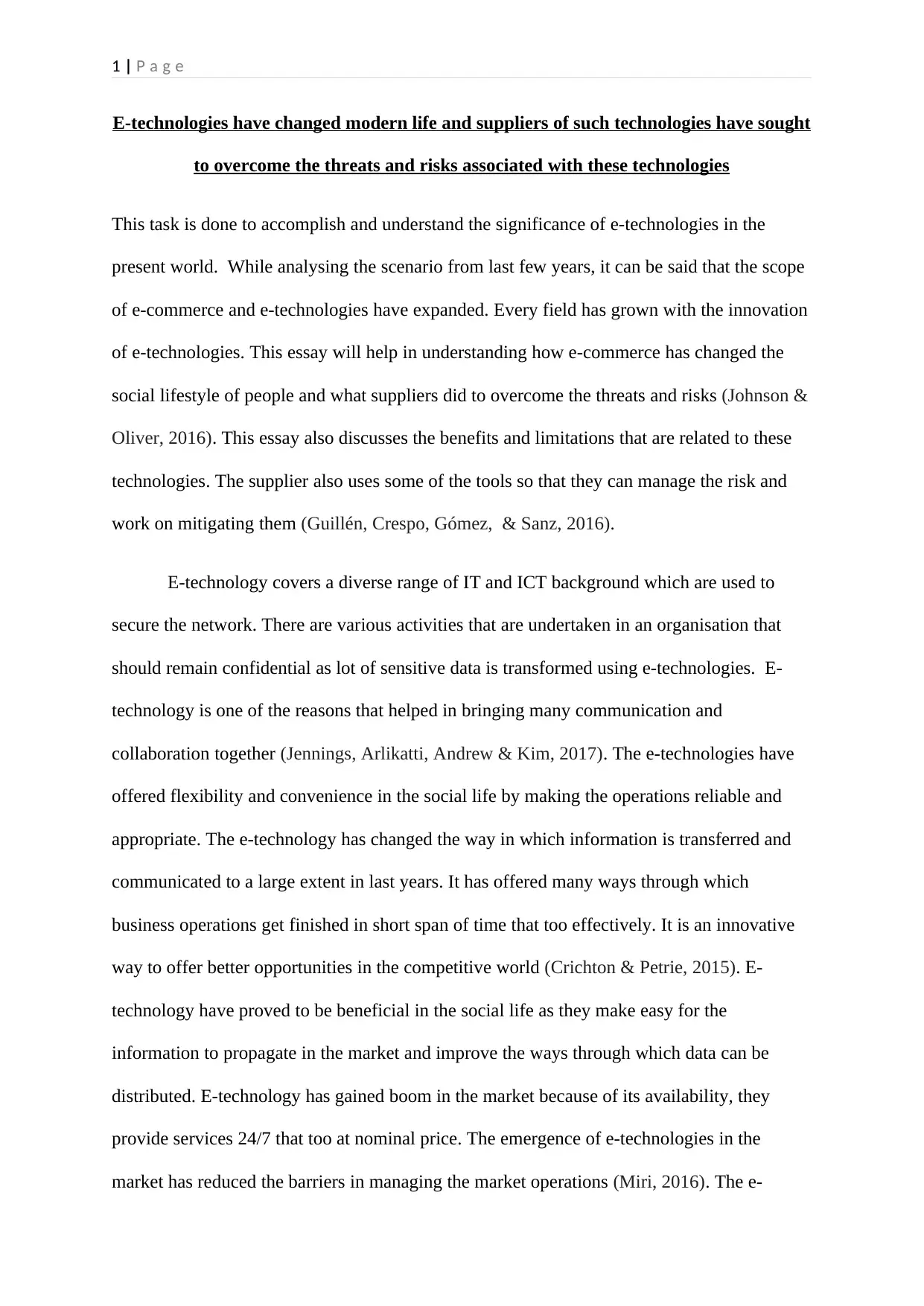
1 | P a g e
E-technologies have changed modern life and suppliers of such technologies have sought
to overcome the threats and risks associated with these technologies
This task is done to accomplish and understand the significance of e-technologies in the
present world. While analysing the scenario from last few years, it can be said that the scope
of e-commerce and e-technologies have expanded. Every field has grown with the innovation
of e-technologies. This essay will help in understanding how e-commerce has changed the
social lifestyle of people and what suppliers did to overcome the threats and risks (Johnson &
Oliver, 2016). This essay also discusses the benefits and limitations that are related to these
technologies. The supplier also uses some of the tools so that they can manage the risk and
work on mitigating them (Guillén, Crespo, Gómez, & Sanz, 2016).
E-technology covers a diverse range of IT and ICT background which are used to
secure the network. There are various activities that are undertaken in an organisation that
should remain confidential as lot of sensitive data is transformed using e-technologies. E-
technology is one of the reasons that helped in bringing many communication and
collaboration together (Jennings, Arlikatti, Andrew & Kim, 2017). The e-technologies have
offered flexibility and convenience in the social life by making the operations reliable and
appropriate. The e-technology has changed the way in which information is transferred and
communicated to a large extent in last years. It has offered many ways through which
business operations get finished in short span of time that too effectively. It is an innovative
way to offer better opportunities in the competitive world (Crichton & Petrie, 2015). E-
technology have proved to be beneficial in the social life as they make easy for the
information to propagate in the market and improve the ways through which data can be
distributed. E-technology has gained boom in the market because of its availability, they
provide services 24/7 that too at nominal price. The emergence of e-technologies in the
market has reduced the barriers in managing the market operations (Miri, 2016). The e-
E-technologies have changed modern life and suppliers of such technologies have sought
to overcome the threats and risks associated with these technologies
This task is done to accomplish and understand the significance of e-technologies in the
present world. While analysing the scenario from last few years, it can be said that the scope
of e-commerce and e-technologies have expanded. Every field has grown with the innovation
of e-technologies. This essay will help in understanding how e-commerce has changed the
social lifestyle of people and what suppliers did to overcome the threats and risks (Johnson &
Oliver, 2016). This essay also discusses the benefits and limitations that are related to these
technologies. The supplier also uses some of the tools so that they can manage the risk and
work on mitigating them (Guillén, Crespo, Gómez, & Sanz, 2016).
E-technology covers a diverse range of IT and ICT background which are used to
secure the network. There are various activities that are undertaken in an organisation that
should remain confidential as lot of sensitive data is transformed using e-technologies. E-
technology is one of the reasons that helped in bringing many communication and
collaboration together (Jennings, Arlikatti, Andrew & Kim, 2017). The e-technologies have
offered flexibility and convenience in the social life by making the operations reliable and
appropriate. The e-technology has changed the way in which information is transferred and
communicated to a large extent in last years. It has offered many ways through which
business operations get finished in short span of time that too effectively. It is an innovative
way to offer better opportunities in the competitive world (Crichton & Petrie, 2015). E-
technology have proved to be beneficial in the social life as they make easy for the
information to propagate in the market and improve the ways through which data can be
distributed. E-technology has gained boom in the market because of its availability, they
provide services 24/7 that too at nominal price. The emergence of e-technologies in the
market has reduced the barriers in managing the market operations (Miri, 2016). The e-
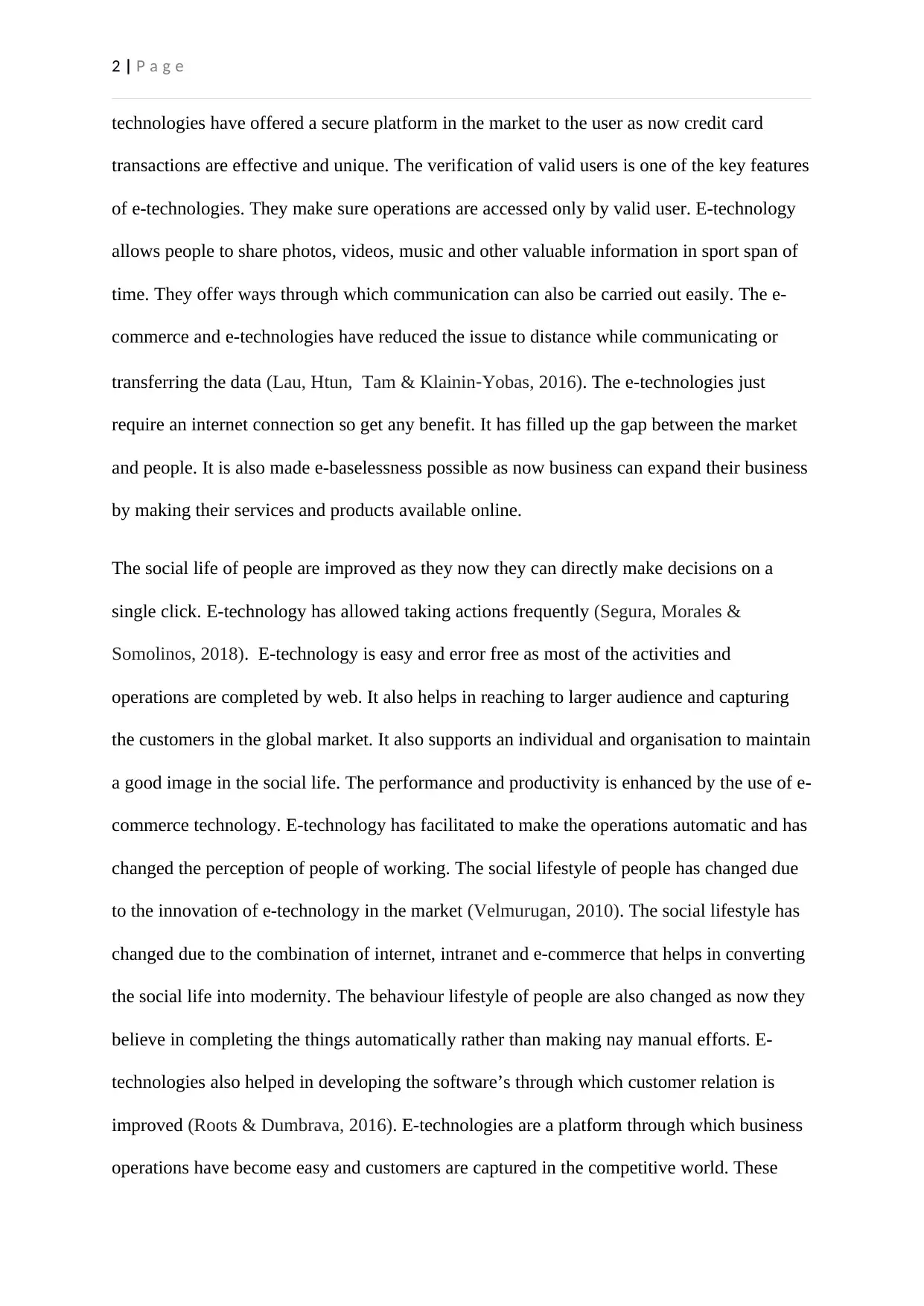
2 | P a g e
technologies have offered a secure platform in the market to the user as now credit card
transactions are effective and unique. The verification of valid users is one of the key features
of e-technologies. They make sure operations are accessed only by valid user. E-technology
allows people to share photos, videos, music and other valuable information in sport span of
time. They offer ways through which communication can also be carried out easily. The e-
commerce and e-technologies have reduced the issue to distance while communicating or
transferring the data (Lau, Htun, Tam & Klainin‐Yobas, 2016). The e-technologies just
require an internet connection so get any benefit. It has filled up the gap between the market
and people. It is also made e-baselessness possible as now business can expand their business
by making their services and products available online.
The social life of people are improved as they now they can directly make decisions on a
single click. E-technology has allowed taking actions frequently (Segura, Morales &
Somolinos, 2018). E-technology is easy and error free as most of the activities and
operations are completed by web. It also helps in reaching to larger audience and capturing
the customers in the global market. It also supports an individual and organisation to maintain
a good image in the social life. The performance and productivity is enhanced by the use of e-
commerce technology. E-technology has facilitated to make the operations automatic and has
changed the perception of people of working. The social lifestyle of people has changed due
to the innovation of e-technology in the market (Velmurugan, 2010). The social lifestyle has
changed due to the combination of internet, intranet and e-commerce that helps in converting
the social life into modernity. The behaviour lifestyle of people are also changed as now they
believe in completing the things automatically rather than making nay manual efforts. E-
technologies also helped in developing the software’s through which customer relation is
improved (Roots & Dumbrava, 2016). E-technologies are a platform through which business
operations have become easy and customers are captured in the competitive world. These
technologies have offered a secure platform in the market to the user as now credit card
transactions are effective and unique. The verification of valid users is one of the key features
of e-technologies. They make sure operations are accessed only by valid user. E-technology
allows people to share photos, videos, music and other valuable information in sport span of
time. They offer ways through which communication can also be carried out easily. The e-
commerce and e-technologies have reduced the issue to distance while communicating or
transferring the data (Lau, Htun, Tam & Klainin‐Yobas, 2016). The e-technologies just
require an internet connection so get any benefit. It has filled up the gap between the market
and people. It is also made e-baselessness possible as now business can expand their business
by making their services and products available online.
The social life of people are improved as they now they can directly make decisions on a
single click. E-technology has allowed taking actions frequently (Segura, Morales &
Somolinos, 2018). E-technology is easy and error free as most of the activities and
operations are completed by web. It also helps in reaching to larger audience and capturing
the customers in the global market. It also supports an individual and organisation to maintain
a good image in the social life. The performance and productivity is enhanced by the use of e-
commerce technology. E-technology has facilitated to make the operations automatic and has
changed the perception of people of working. The social lifestyle of people has changed due
to the innovation of e-technology in the market (Velmurugan, 2010). The social lifestyle has
changed due to the combination of internet, intranet and e-commerce that helps in converting
the social life into modernity. The behaviour lifestyle of people are also changed as now they
believe in completing the things automatically rather than making nay manual efforts. E-
technologies also helped in developing the software’s through which customer relation is
improved (Roots & Dumbrava, 2016). E-technologies are a platform through which business
operations have become easy and customers are captured in the competitive world. These
⊘ This is a preview!⊘
Do you want full access?
Subscribe today to unlock all pages.

Trusted by 1+ million students worldwide
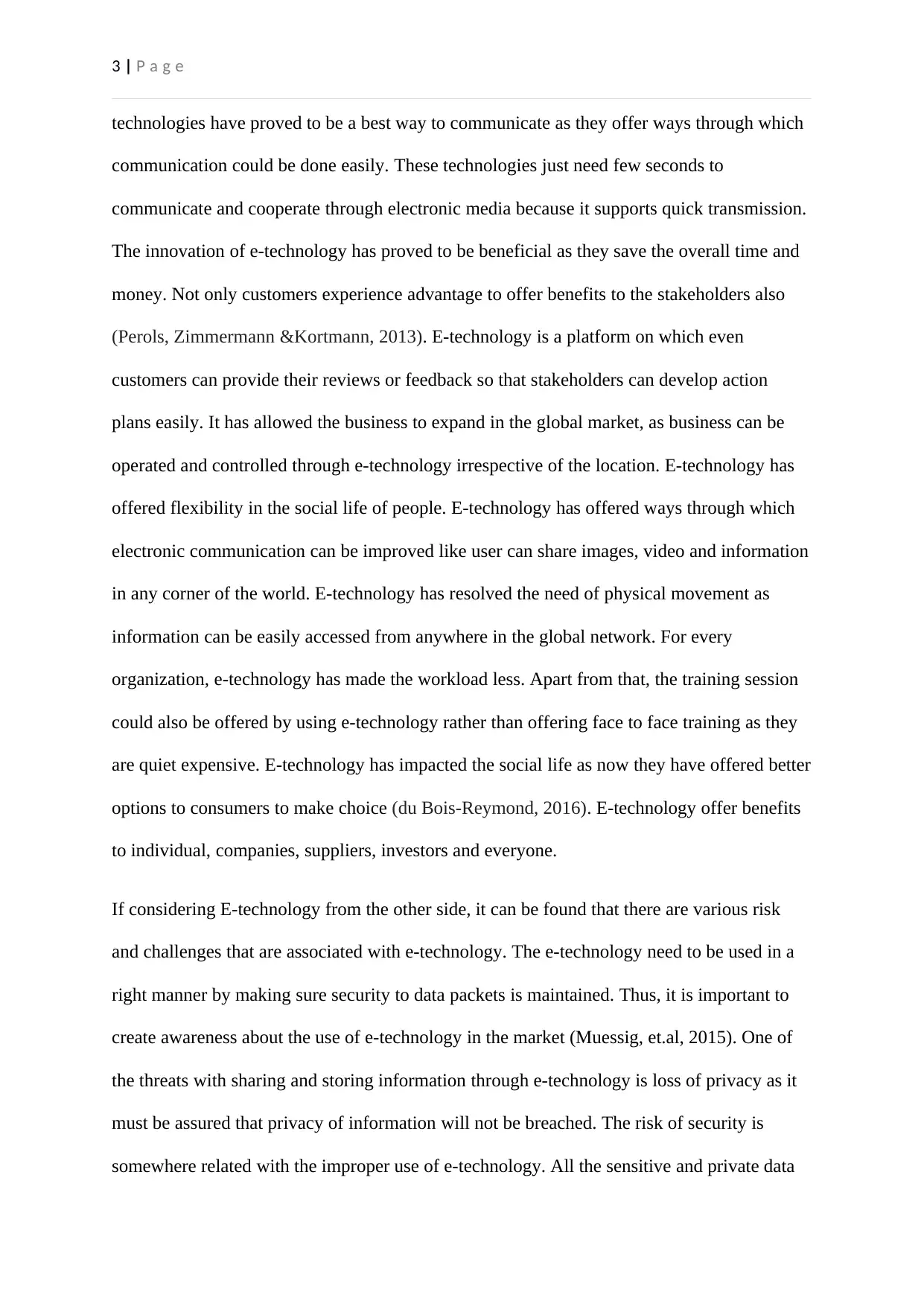
3 | P a g e
technologies have proved to be a best way to communicate as they offer ways through which
communication could be done easily. These technologies just need few seconds to
communicate and cooperate through electronic media because it supports quick transmission.
The innovation of e-technology has proved to be beneficial as they save the overall time and
money. Not only customers experience advantage to offer benefits to the stakeholders also
(Perols, Zimmermann &Kortmann, 2013). E-technology is a platform on which even
customers can provide their reviews or feedback so that stakeholders can develop action
plans easily. It has allowed the business to expand in the global market, as business can be
operated and controlled through e-technology irrespective of the location. E-technology has
offered flexibility in the social life of people. E-technology has offered ways through which
electronic communication can be improved like user can share images, video and information
in any corner of the world. E-technology has resolved the need of physical movement as
information can be easily accessed from anywhere in the global network. For every
organization, e-technology has made the workload less. Apart from that, the training session
could also be offered by using e-technology rather than offering face to face training as they
are quiet expensive. E-technology has impacted the social life as now they have offered better
options to consumers to make choice (du Bois-Reymond, 2016). E-technology offer benefits
to individual, companies, suppliers, investors and everyone.
If considering E-technology from the other side, it can be found that there are various risk
and challenges that are associated with e-technology. The e-technology need to be used in a
right manner by making sure security to data packets is maintained. Thus, it is important to
create awareness about the use of e-technology in the market (Muessig, et.al, 2015). One of
the threats with sharing and storing information through e-technology is loss of privacy as it
must be assured that privacy of information will not be breached. The risk of security is
somewhere related with the improper use of e-technology. All the sensitive and private data
technologies have proved to be a best way to communicate as they offer ways through which
communication could be done easily. These technologies just need few seconds to
communicate and cooperate through electronic media because it supports quick transmission.
The innovation of e-technology has proved to be beneficial as they save the overall time and
money. Not only customers experience advantage to offer benefits to the stakeholders also
(Perols, Zimmermann &Kortmann, 2013). E-technology is a platform on which even
customers can provide their reviews or feedback so that stakeholders can develop action
plans easily. It has allowed the business to expand in the global market, as business can be
operated and controlled through e-technology irrespective of the location. E-technology has
offered flexibility in the social life of people. E-technology has offered ways through which
electronic communication can be improved like user can share images, video and information
in any corner of the world. E-technology has resolved the need of physical movement as
information can be easily accessed from anywhere in the global network. For every
organization, e-technology has made the workload less. Apart from that, the training session
could also be offered by using e-technology rather than offering face to face training as they
are quiet expensive. E-technology has impacted the social life as now they have offered better
options to consumers to make choice (du Bois-Reymond, 2016). E-technology offer benefits
to individual, companies, suppliers, investors and everyone.
If considering E-technology from the other side, it can be found that there are various risk
and challenges that are associated with e-technology. The e-technology need to be used in a
right manner by making sure security to data packets is maintained. Thus, it is important to
create awareness about the use of e-technology in the market (Muessig, et.al, 2015). One of
the threats with sharing and storing information through e-technology is loss of privacy as it
must be assured that privacy of information will not be breached. The risk of security is
somewhere related with the improper use of e-technology. All the sensitive and private data
Paraphrase This Document
Need a fresh take? Get an instant paraphrase of this document with our AI Paraphraser
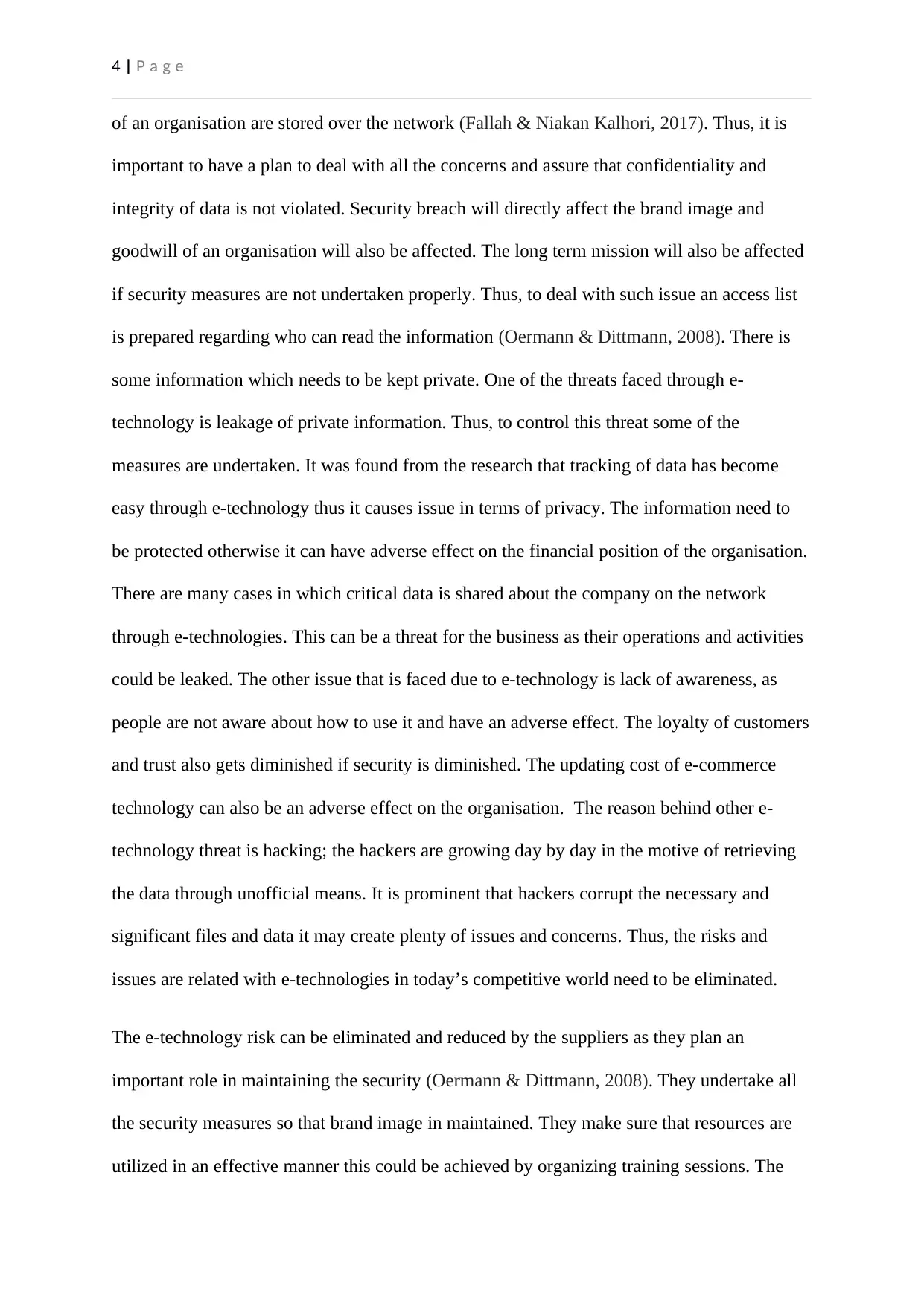
4 | P a g e
of an organisation are stored over the network (Fallah & Niakan Kalhori, 2017). Thus, it is
important to have a plan to deal with all the concerns and assure that confidentiality and
integrity of data is not violated. Security breach will directly affect the brand image and
goodwill of an organisation will also be affected. The long term mission will also be affected
if security measures are not undertaken properly. Thus, to deal with such issue an access list
is prepared regarding who can read the information (Oermann & Dittmann, 2008). There is
some information which needs to be kept private. One of the threats faced through e-
technology is leakage of private information. Thus, to control this threat some of the
measures are undertaken. It was found from the research that tracking of data has become
easy through e-technology thus it causes issue in terms of privacy. The information need to
be protected otherwise it can have adverse effect on the financial position of the organisation.
There are many cases in which critical data is shared about the company on the network
through e-technologies. This can be a threat for the business as their operations and activities
could be leaked. The other issue that is faced due to e-technology is lack of awareness, as
people are not aware about how to use it and have an adverse effect. The loyalty of customers
and trust also gets diminished if security is diminished. The updating cost of e-commerce
technology can also be an adverse effect on the organisation. The reason behind other e-
technology threat is hacking; the hackers are growing day by day in the motive of retrieving
the data through unofficial means. It is prominent that hackers corrupt the necessary and
significant files and data it may create plenty of issues and concerns. Thus, the risks and
issues are related with e-technologies in today’s competitive world need to be eliminated.
The e-technology risk can be eliminated and reduced by the suppliers as they plan an
important role in maintaining the security (Oermann & Dittmann, 2008). They undertake all
the security measures so that brand image in maintained. They make sure that resources are
utilized in an effective manner this could be achieved by organizing training sessions. The
of an organisation are stored over the network (Fallah & Niakan Kalhori, 2017). Thus, it is
important to have a plan to deal with all the concerns and assure that confidentiality and
integrity of data is not violated. Security breach will directly affect the brand image and
goodwill of an organisation will also be affected. The long term mission will also be affected
if security measures are not undertaken properly. Thus, to deal with such issue an access list
is prepared regarding who can read the information (Oermann & Dittmann, 2008). There is
some information which needs to be kept private. One of the threats faced through e-
technology is leakage of private information. Thus, to control this threat some of the
measures are undertaken. It was found from the research that tracking of data has become
easy through e-technology thus it causes issue in terms of privacy. The information need to
be protected otherwise it can have adverse effect on the financial position of the organisation.
There are many cases in which critical data is shared about the company on the network
through e-technologies. This can be a threat for the business as their operations and activities
could be leaked. The other issue that is faced due to e-technology is lack of awareness, as
people are not aware about how to use it and have an adverse effect. The loyalty of customers
and trust also gets diminished if security is diminished. The updating cost of e-commerce
technology can also be an adverse effect on the organisation. The reason behind other e-
technology threat is hacking; the hackers are growing day by day in the motive of retrieving
the data through unofficial means. It is prominent that hackers corrupt the necessary and
significant files and data it may create plenty of issues and concerns. Thus, the risks and
issues are related with e-technologies in today’s competitive world need to be eliminated.
The e-technology risk can be eliminated and reduced by the suppliers as they plan an
important role in maintaining the security (Oermann & Dittmann, 2008). They undertake all
the security measures so that brand image in maintained. They make sure that resources are
utilized in an effective manner this could be achieved by organizing training sessions. The
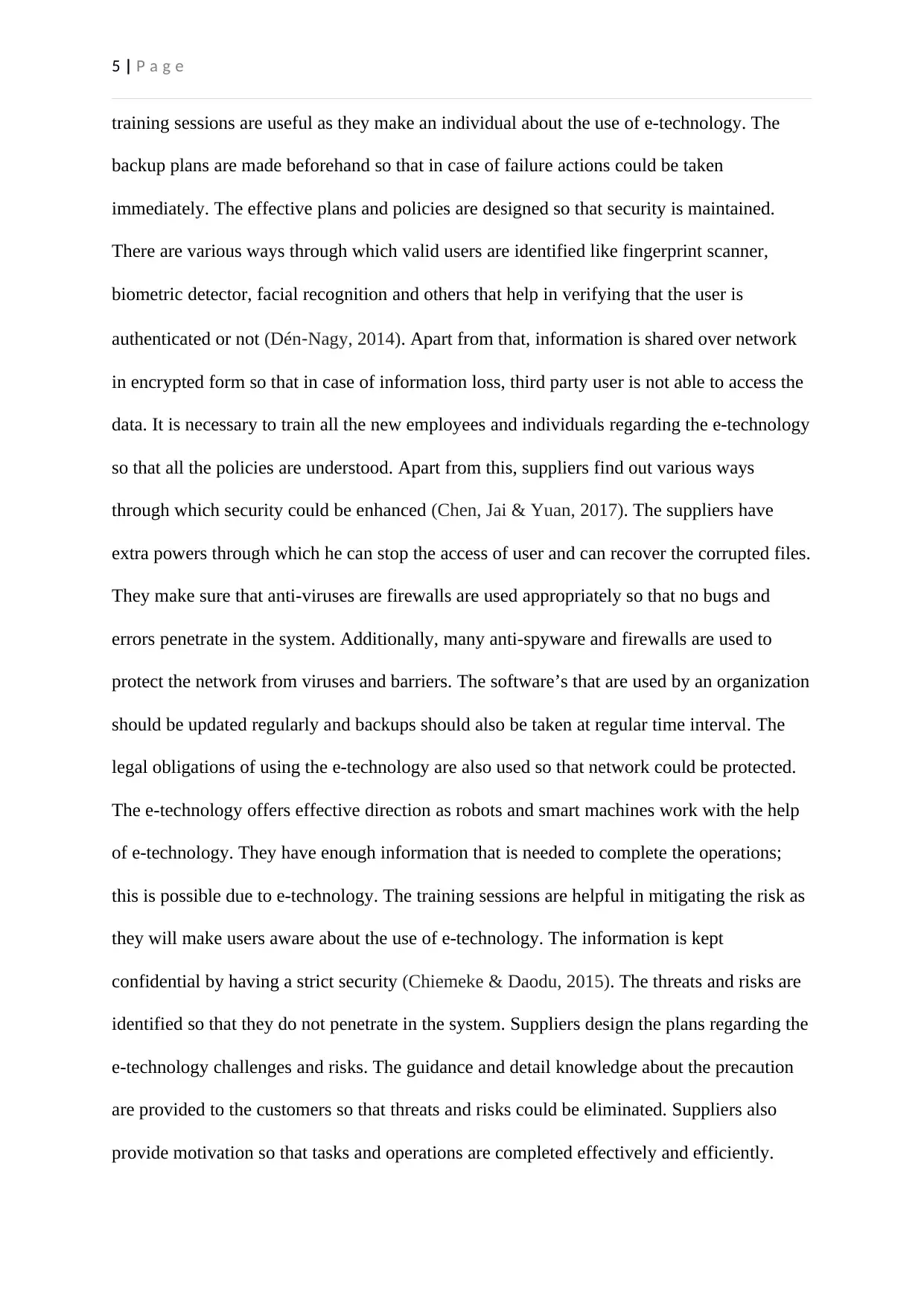
5 | P a g e
training sessions are useful as they make an individual about the use of e-technology. The
backup plans are made beforehand so that in case of failure actions could be taken
immediately. The effective plans and policies are designed so that security is maintained.
There are various ways through which valid users are identified like fingerprint scanner,
biometric detector, facial recognition and others that help in verifying that the user is
authenticated or not (Dén‐Nagy, 2014). Apart from that, information is shared over network
in encrypted form so that in case of information loss, third party user is not able to access the
data. It is necessary to train all the new employees and individuals regarding the e-technology
so that all the policies are understood. Apart from this, suppliers find out various ways
through which security could be enhanced (Chen, Jai & Yuan, 2017). The suppliers have
extra powers through which he can stop the access of user and can recover the corrupted files.
They make sure that anti-viruses are firewalls are used appropriately so that no bugs and
errors penetrate in the system. Additionally, many anti-spyware and firewalls are used to
protect the network from viruses and barriers. The software’s that are used by an organization
should be updated regularly and backups should also be taken at regular time interval. The
legal obligations of using the e-technology are also used so that network could be protected.
The e-technology offers effective direction as robots and smart machines work with the help
of e-technology. They have enough information that is needed to complete the operations;
this is possible due to e-technology. The training sessions are helpful in mitigating the risk as
they will make users aware about the use of e-technology. The information is kept
confidential by having a strict security (Chiemeke & Daodu, 2015). The threats and risks are
identified so that they do not penetrate in the system. Suppliers design the plans regarding the
e-technology challenges and risks. The guidance and detail knowledge about the precaution
are provided to the customers so that threats and risks could be eliminated. Suppliers also
provide motivation so that tasks and operations are completed effectively and efficiently.
training sessions are useful as they make an individual about the use of e-technology. The
backup plans are made beforehand so that in case of failure actions could be taken
immediately. The effective plans and policies are designed so that security is maintained.
There are various ways through which valid users are identified like fingerprint scanner,
biometric detector, facial recognition and others that help in verifying that the user is
authenticated or not (Dén‐Nagy, 2014). Apart from that, information is shared over network
in encrypted form so that in case of information loss, third party user is not able to access the
data. It is necessary to train all the new employees and individuals regarding the e-technology
so that all the policies are understood. Apart from this, suppliers find out various ways
through which security could be enhanced (Chen, Jai & Yuan, 2017). The suppliers have
extra powers through which he can stop the access of user and can recover the corrupted files.
They make sure that anti-viruses are firewalls are used appropriately so that no bugs and
errors penetrate in the system. Additionally, many anti-spyware and firewalls are used to
protect the network from viruses and barriers. The software’s that are used by an organization
should be updated regularly and backups should also be taken at regular time interval. The
legal obligations of using the e-technology are also used so that network could be protected.
The e-technology offers effective direction as robots and smart machines work with the help
of e-technology. They have enough information that is needed to complete the operations;
this is possible due to e-technology. The training sessions are helpful in mitigating the risk as
they will make users aware about the use of e-technology. The information is kept
confidential by having a strict security (Chiemeke & Daodu, 2015). The threats and risks are
identified so that they do not penetrate in the system. Suppliers design the plans regarding the
e-technology challenges and risks. The guidance and detail knowledge about the precaution
are provided to the customers so that threats and risks could be eliminated. Suppliers also
provide motivation so that tasks and operations are completed effectively and efficiently.
⊘ This is a preview!⊘
Do you want full access?
Subscribe today to unlock all pages.

Trusted by 1+ million students worldwide
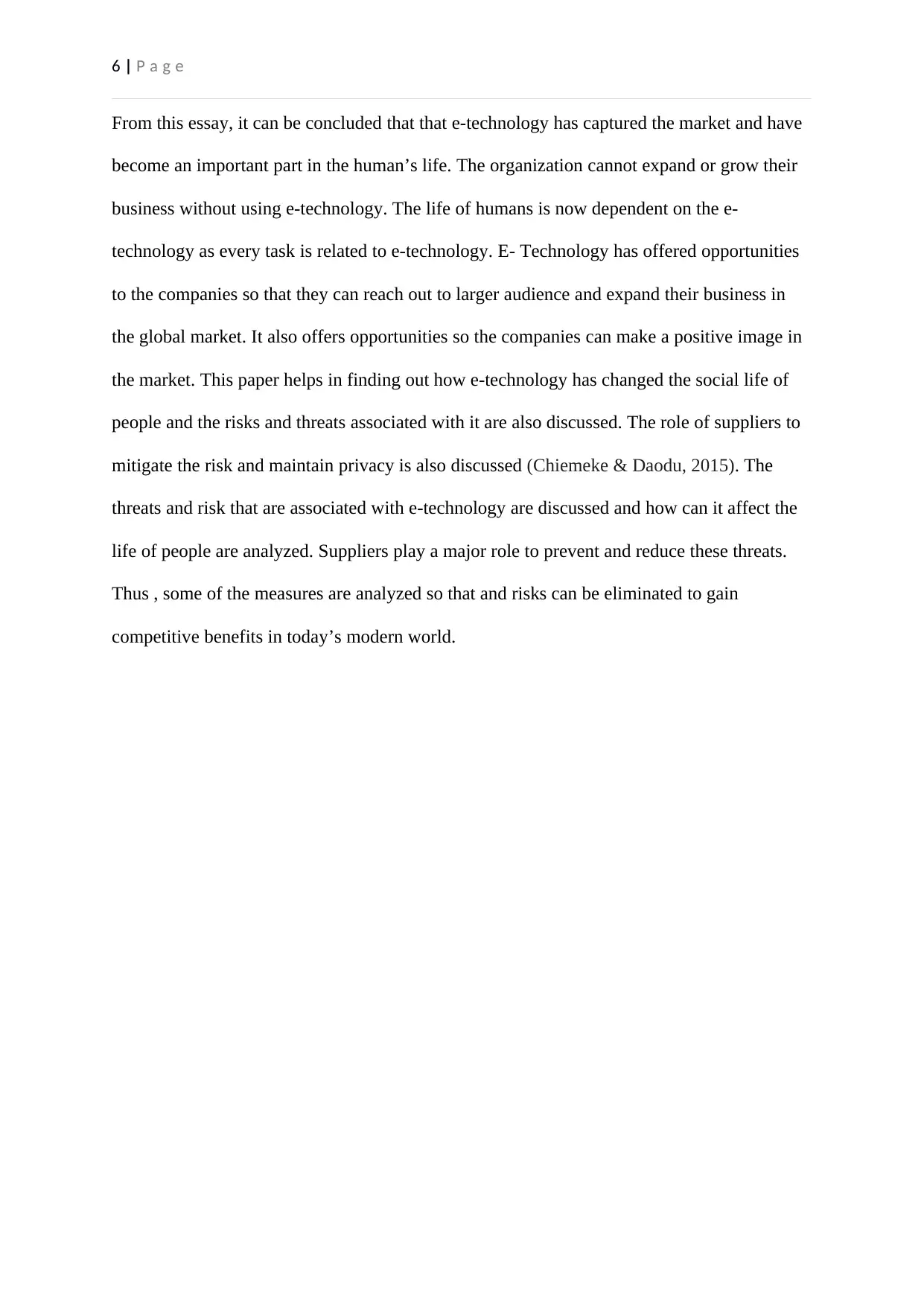
6 | P a g e
From this essay, it can be concluded that that e-technology has captured the market and have
become an important part in the human’s life. The organization cannot expand or grow their
business without using e-technology. The life of humans is now dependent on the e-
technology as every task is related to e-technology. E- Technology has offered opportunities
to the companies so that they can reach out to larger audience and expand their business in
the global market. It also offers opportunities so the companies can make a positive image in
the market. This paper helps in finding out how e-technology has changed the social life of
people and the risks and threats associated with it are also discussed. The role of suppliers to
mitigate the risk and maintain privacy is also discussed (Chiemeke & Daodu, 2015). The
threats and risk that are associated with e-technology are discussed and how can it affect the
life of people are analyzed. Suppliers play a major role to prevent and reduce these threats.
Thus , some of the measures are analyzed so that and risks can be eliminated to gain
competitive benefits in today’s modern world.
From this essay, it can be concluded that that e-technology has captured the market and have
become an important part in the human’s life. The organization cannot expand or grow their
business without using e-technology. The life of humans is now dependent on the e-
technology as every task is related to e-technology. E- Technology has offered opportunities
to the companies so that they can reach out to larger audience and expand their business in
the global market. It also offers opportunities so the companies can make a positive image in
the market. This paper helps in finding out how e-technology has changed the social life of
people and the risks and threats associated with it are also discussed. The role of suppliers to
mitigate the risk and maintain privacy is also discussed (Chiemeke & Daodu, 2015). The
threats and risk that are associated with e-technology are discussed and how can it affect the
life of people are analyzed. Suppliers play a major role to prevent and reduce these threats.
Thus , some of the measures are analyzed so that and risks can be eliminated to gain
competitive benefits in today’s modern world.
Paraphrase This Document
Need a fresh take? Get an instant paraphrase of this document with our AI Paraphraser
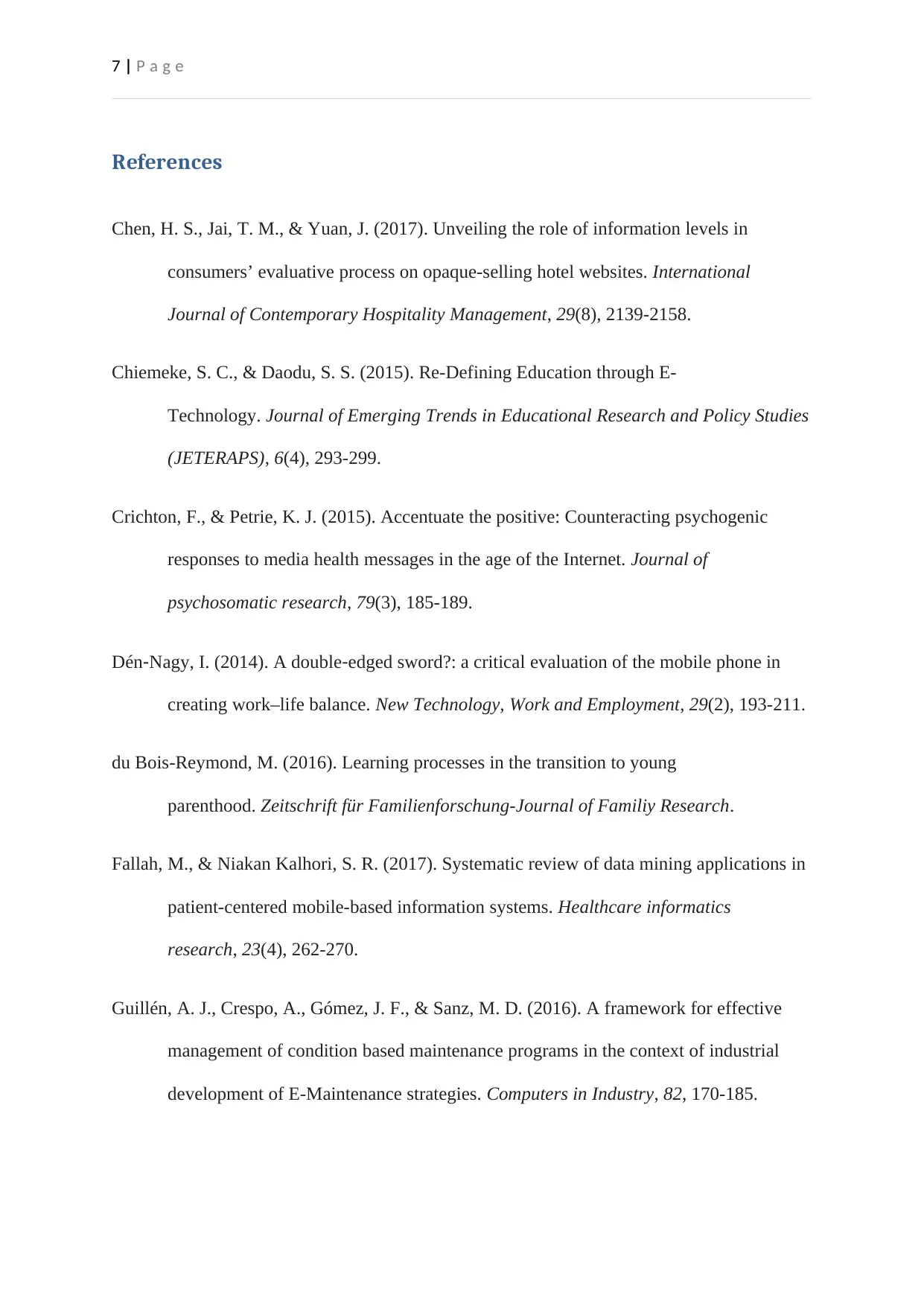
7 | P a g e
References
Chen, H. S., Jai, T. M., & Yuan, J. (2017). Unveiling the role of information levels in
consumers’ evaluative process on opaque-selling hotel websites. International
Journal of Contemporary Hospitality Management, 29(8), 2139-2158.
Chiemeke, S. C., & Daodu, S. S. (2015). Re-Defining Education through E-
Technology. Journal of Emerging Trends in Educational Research and Policy Studies
(JETERAPS), 6(4), 293-299.
Crichton, F., & Petrie, K. J. (2015). Accentuate the positive: Counteracting psychogenic
responses to media health messages in the age of the Internet. Journal of
psychosomatic research, 79(3), 185-189.
Dén‐Nagy, I. (2014). A double‐edged sword?: a critical evaluation of the mobile phone in
creating work–life balance. New Technology, Work and Employment, 29(2), 193-211.
du Bois-Reymond, M. (2016). Learning processes in the transition to young
parenthood. Zeitschrift für Familienforschung-Journal of Familiy Research.
Fallah, M., & Niakan Kalhori, S. R. (2017). Systematic review of data mining applications in
patient-centered mobile-based information systems. Healthcare informatics
research, 23(4), 262-270.
Guillén, A. J., Crespo, A., Gómez, J. F., & Sanz, M. D. (2016). A framework for effective
management of condition based maintenance programs in the context of industrial
development of E-Maintenance strategies. Computers in Industry, 82, 170-185.
References
Chen, H. S., Jai, T. M., & Yuan, J. (2017). Unveiling the role of information levels in
consumers’ evaluative process on opaque-selling hotel websites. International
Journal of Contemporary Hospitality Management, 29(8), 2139-2158.
Chiemeke, S. C., & Daodu, S. S. (2015). Re-Defining Education through E-
Technology. Journal of Emerging Trends in Educational Research and Policy Studies
(JETERAPS), 6(4), 293-299.
Crichton, F., & Petrie, K. J. (2015). Accentuate the positive: Counteracting psychogenic
responses to media health messages in the age of the Internet. Journal of
psychosomatic research, 79(3), 185-189.
Dén‐Nagy, I. (2014). A double‐edged sword?: a critical evaluation of the mobile phone in
creating work–life balance. New Technology, Work and Employment, 29(2), 193-211.
du Bois-Reymond, M. (2016). Learning processes in the transition to young
parenthood. Zeitschrift für Familienforschung-Journal of Familiy Research.
Fallah, M., & Niakan Kalhori, S. R. (2017). Systematic review of data mining applications in
patient-centered mobile-based information systems. Healthcare informatics
research, 23(4), 262-270.
Guillén, A. J., Crespo, A., Gómez, J. F., & Sanz, M. D. (2016). A framework for effective
management of condition based maintenance programs in the context of industrial
development of E-Maintenance strategies. Computers in Industry, 82, 170-185.
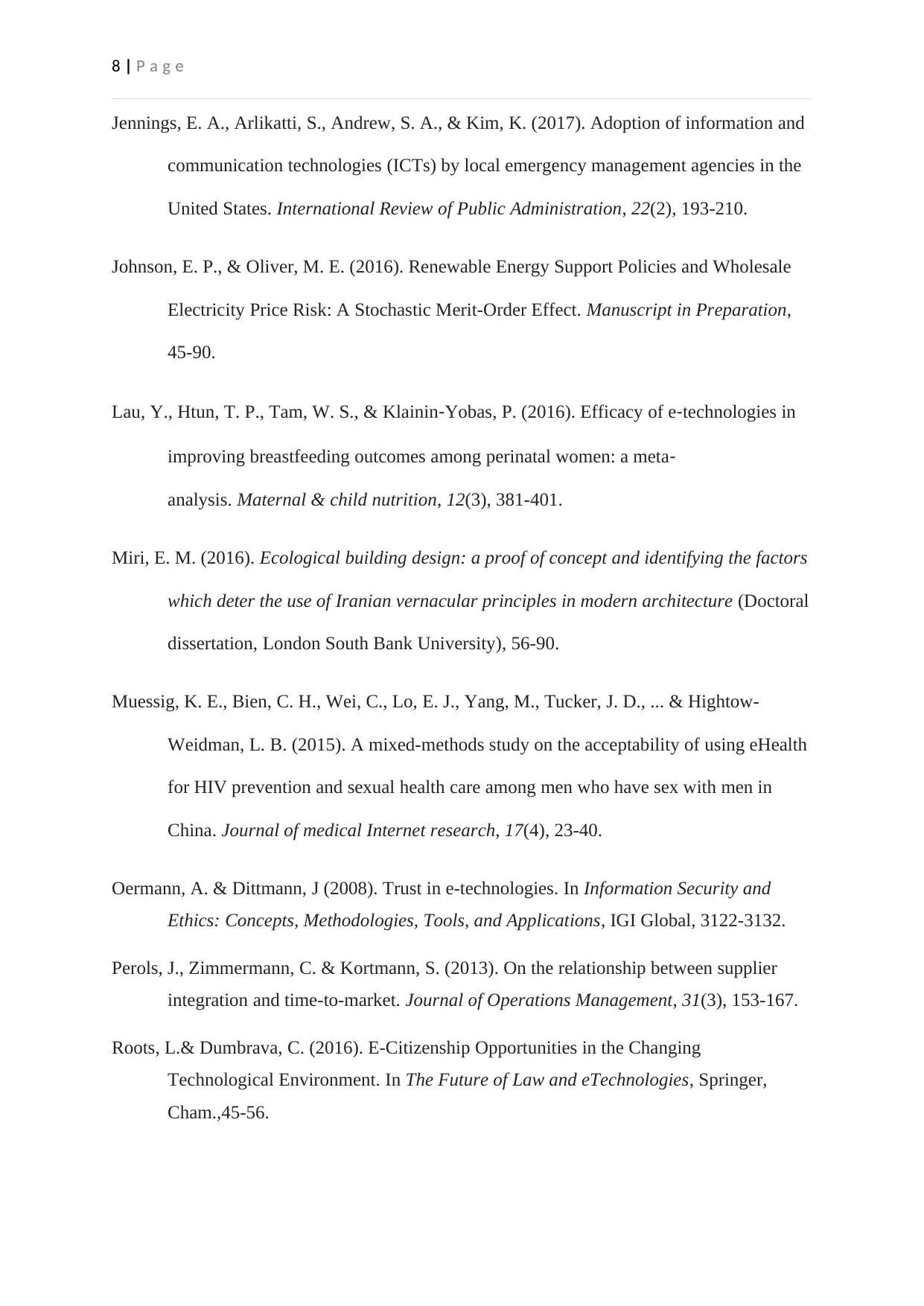
8 | P a g e
Jennings, E. A., Arlikatti, S., Andrew, S. A., & Kim, K. (2017). Adoption of information and
communication technologies (ICTs) by local emergency management agencies in the
United States. International Review of Public Administration, 22(2), 193-210.
Johnson, E. P., & Oliver, M. E. (2016). Renewable Energy Support Policies and Wholesale
Electricity Price Risk: A Stochastic Merit-Order Effect. Manuscript in Preparation,
45-90.
Lau, Y., Htun, T. P., Tam, W. S., & Klainin‐Yobas, P. (2016). Efficacy of e‐technologies in
improving breastfeeding outcomes among perinatal women: a meta‐
analysis. Maternal & child nutrition, 12(3), 381-401.
Miri, E. M. (2016). Ecological building design: a proof of concept and identifying the factors
which deter the use of Iranian vernacular principles in modern architecture (Doctoral
dissertation, London South Bank University), 56-90.
Muessig, K. E., Bien, C. H., Wei, C., Lo, E. J., Yang, M., Tucker, J. D., ... & Hightow-
Weidman, L. B. (2015). A mixed-methods study on the acceptability of using eHealth
for HIV prevention and sexual health care among men who have sex with men in
China. Journal of medical Internet research, 17(4), 23-40.
Oermann, A. & Dittmann, J (2008). Trust in e-technologies. In Information Security and
Ethics: Concepts, Methodologies, Tools, and Applications, IGI Global, 3122-3132.
Perols, J., Zimmermann, C. & Kortmann, S. (2013). On the relationship between supplier
integration and time-to-market. Journal of Operations Management, 31(3), 153-167.
Roots, L.& Dumbrava, C. (2016). E-Citizenship Opportunities in the Changing
Technological Environment. In The Future of Law and eTechnologies, Springer,
Cham.,45-56.
Jennings, E. A., Arlikatti, S., Andrew, S. A., & Kim, K. (2017). Adoption of information and
communication technologies (ICTs) by local emergency management agencies in the
United States. International Review of Public Administration, 22(2), 193-210.
Johnson, E. P., & Oliver, M. E. (2016). Renewable Energy Support Policies and Wholesale
Electricity Price Risk: A Stochastic Merit-Order Effect. Manuscript in Preparation,
45-90.
Lau, Y., Htun, T. P., Tam, W. S., & Klainin‐Yobas, P. (2016). Efficacy of e‐technologies in
improving breastfeeding outcomes among perinatal women: a meta‐
analysis. Maternal & child nutrition, 12(3), 381-401.
Miri, E. M. (2016). Ecological building design: a proof of concept and identifying the factors
which deter the use of Iranian vernacular principles in modern architecture (Doctoral
dissertation, London South Bank University), 56-90.
Muessig, K. E., Bien, C. H., Wei, C., Lo, E. J., Yang, M., Tucker, J. D., ... & Hightow-
Weidman, L. B. (2015). A mixed-methods study on the acceptability of using eHealth
for HIV prevention and sexual health care among men who have sex with men in
China. Journal of medical Internet research, 17(4), 23-40.
Oermann, A. & Dittmann, J (2008). Trust in e-technologies. In Information Security and
Ethics: Concepts, Methodologies, Tools, and Applications, IGI Global, 3122-3132.
Perols, J., Zimmermann, C. & Kortmann, S. (2013). On the relationship between supplier
integration and time-to-market. Journal of Operations Management, 31(3), 153-167.
Roots, L.& Dumbrava, C. (2016). E-Citizenship Opportunities in the Changing
Technological Environment. In The Future of Law and eTechnologies, Springer,
Cham.,45-56.
⊘ This is a preview!⊘
Do you want full access?
Subscribe today to unlock all pages.

Trusted by 1+ million students worldwide
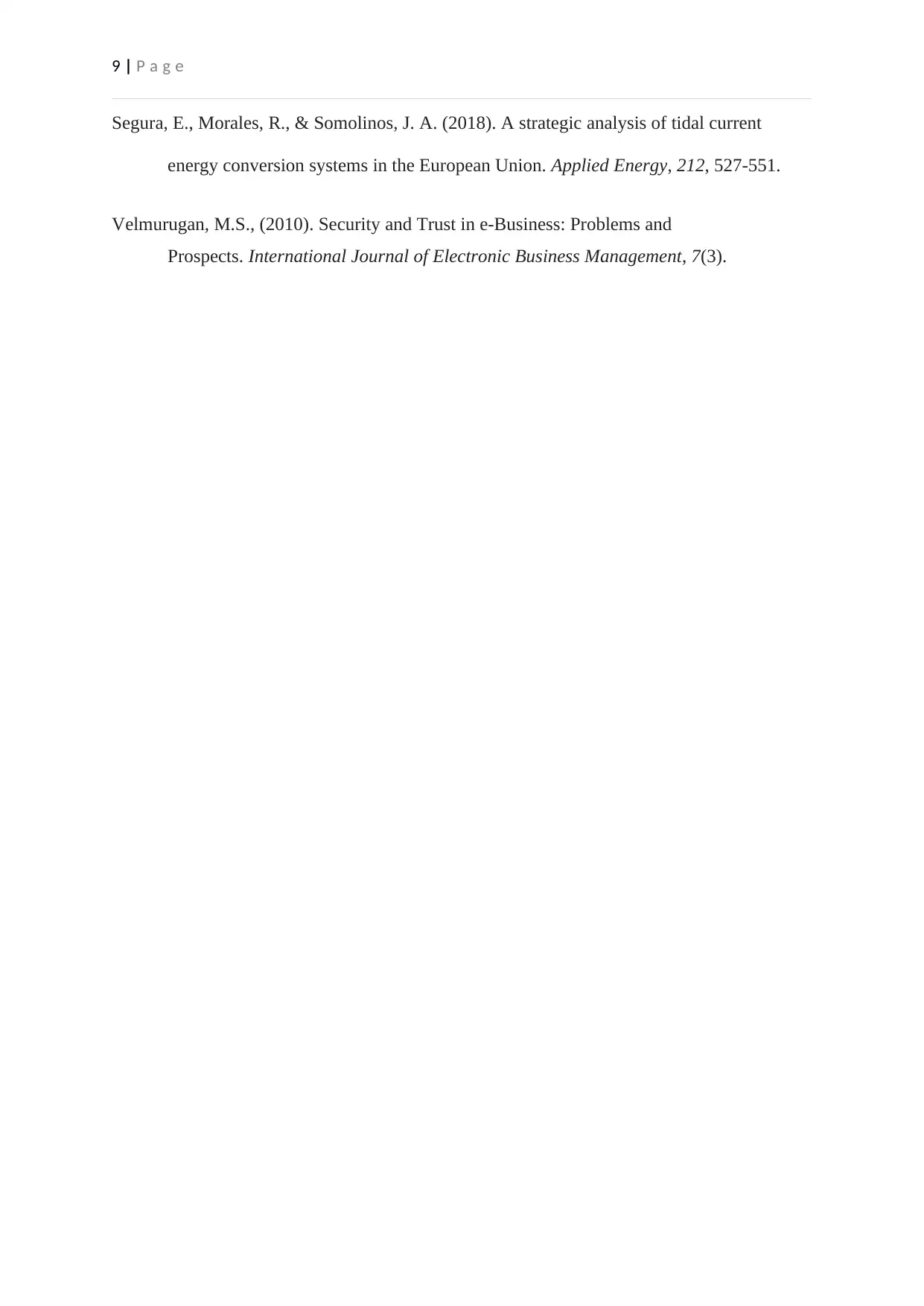
9 | P a g e
Segura, E., Morales, R., & Somolinos, J. A. (2018). A strategic analysis of tidal current
energy conversion systems in the European Union. Applied Energy, 212, 527-551.
Velmurugan, M.S., (2010). Security and Trust in e-Business: Problems and
Prospects. International Journal of Electronic Business Management, 7(3).
Segura, E., Morales, R., & Somolinos, J. A. (2018). A strategic analysis of tidal current
energy conversion systems in the European Union. Applied Energy, 212, 527-551.
Velmurugan, M.S., (2010). Security and Trust in e-Business: Problems and
Prospects. International Journal of Electronic Business Management, 7(3).
1 out of 10
Related Documents
Your All-in-One AI-Powered Toolkit for Academic Success.
+13062052269
info@desklib.com
Available 24*7 on WhatsApp / Email
![[object Object]](/_next/static/media/star-bottom.7253800d.svg)
Unlock your academic potential
Copyright © 2020–2025 A2Z Services. All Rights Reserved. Developed and managed by ZUCOL.





